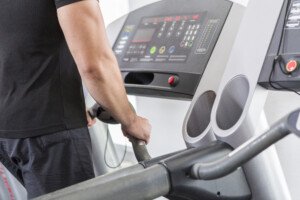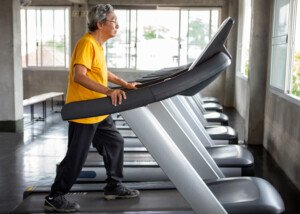
People have often told me that the reason they keep their hands on the front bar of a treadmill is to have a continuous heart rate reading.
Keeping your hands on the treadmill’s heart rate sensors is bad for your workout for many reasons.
It produces an artificial walking environment. The natural walking gait consists of some degree of arm swing.
Holding on disrupts natural movement and can cause “molding” of forward posture (a very bad thing) in tall people, who must slump forward to keep their hands on those heart rate sensors.
The disrupted gait results in several additional negative issues:
-Significant reduction in calorie expenditure. The calorie reading is generated by the treadmill’s motor (and incline), not by the person using it.
-Significant subtraction of workload; activation of key muscle groups is inhibited.
-Potential repetitive stress injuries in the hips, which ballistically move to compensate for the locked-up upper body.
-Deactivation of the body’s balancing mechanism; the exerciser will actually experience reduction in their ability to balance when walking outside on uneven surfaces.
-Rise in blood pressure. If you’re gripping tightly to the heart rate monitors while using a fast pace, this will, indeed, raise blood pressure.
Continuously holding onto a treadmill for heart rate can also lead to obsessing about heart rate.
Before you know it, you’re constantly checking the reading, fixating too much on this element.
Besides, do you really know with absolute certainty if the treadmill’s heart rate reading is even accurate?
A better way to take heart rate is to pause on the machine (feet straddling the tread) and place your finger to your neck or wrist, and count the beats.
Even though you’re standing still while doing this, it’ll still give you a good idea.
If you have doctor’s orders not to exceed a certain heart rate, keep in mind the following:
Continuous tight holding onto the heart rate sensors will raise blood pressure.
Figure out the speed that keeps your pulse below the doctor’s limit, then simply continue at that pace and swing your arms.

Shutterstock/Khakimullin Aleksandr
To ensure that your pulse will not exceed the limit despite this maintenance pace, check it five minutes later.
Check it every 10 minutes for peace of mind. This means every 10 minutes, your hands are on the sensors for 30 seconds, versus continuously: a whopping difference as far as exercise efficiency.
You can learn to take your pulse while walking naturally by lightly placing your fingers on your neck.
Finally, some treadmill models will cease to operate unless you keep your hands on the heart rate monitor.
Switch the program to avoid this problem. If the machine keeps giving orders to hold on, and will continue operating even if you let go, then just ignore the computer’s orders and swing your arms.
 Lorra Garrick is a former personal trainer certified through the American Council on Exercise. At Bally Total Fitness she trained women and men of all ages for fat loss, muscle building, fitness and improved health.
Lorra Garrick is a former personal trainer certified through the American Council on Exercise. At Bally Total Fitness she trained women and men of all ages for fat loss, muscle building, fitness and improved health.
.


























